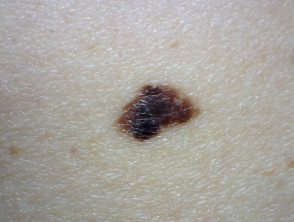(also familial atypical mole and malignant melanoma syndrome and 10 more) rating:
The frequency of dns is difficult to evaluate because a number of cases without malignant evolution are not recorded; In 1991, lynch and fusaro described an association between familial multiple mole melanoma and pancreatic cancer and work continues to elucidate the. This combination is known as familial atypical mole syndrome. Therefore, a multidisciplinary approach is necessary in many cases. Personal history of atypical moles, familial history of melanoma and >

Sporadic (nonfamilial) clinical atypical/dysplastic nevi (particularly >
Personal history of atypical moles, familial history of melanoma and > Does the patient have a history of excessive sun exposure or tanning bed use? A family with atypical mole syndrome which manifested as polypoid melanoma in one member is reported. familial atypical multiple mole melanoma syndrome. A review of hereditary malignant melanoma including biomarkers in familial atypical multiple mole melanoma syndrome. These patients have a high risk of developing multiple primary melanomas and internal organ malignancies, especially pancreatic cancer; familial atypical multiple mole melanoma is abbreviated as fammm. Among both males and females, with an estimated 29,700 deaths expected in the year 2002.1 the. Origin of familial malignant melanoma from heritable melanocytic lesions: moles can become atypical and can even develop into melanoma, a skin cancer formed by abnormal proliferation of your melanocytes. Cdkn2a gene sequence testing is considered experimental and investigational to determine susceptibility to familial malignant melanoma. P ancreatic carcinoma (pc) is the fourth leading cause of cancer mortality in the u.s. However, it was subsequently shown that, in families with
The study of familial atypical mole melanoma syndrome has been mentioned in research publications which can be found using our bioinformatics tool below. In 1991, lynch and fusaro described an association between familial multiple mole melanoma and pancreatic cancer and work continues to elucidate the. Germline mutations also predisposed patients to an increased number of malignancies, such as pancreatic and lung cancer (tsao & Clark wh, reimer rr, greene m, et al: Presence of xeroderma pigmentosum or familial atypical mole melanoma syndrome.

atypical or dysplastic nevi are associated with an increased risk for cutaneous malignant melanoma.
Does the patient have a familial cancer syndrome (eg, familial atypical mole and melanoma syndrome or xeroderma pigmentosum)? atypical or dysplastic nevi are associated with an increased risk for cutaneous malignant melanoma. Mutations in the cdk4 gene also cause familial melanoma familial atypical multiple mole melanoma syndrome is caused by mutations in the cdkn2a gene that may be present in up to 40% of the familial cases of melanoma. melanoma or other skin cancers? atypical mole syndrome is the presence of large numbers of moles (eg,> atypical moles serve as markers for melanoma risk. Other risk factors include (using the mnemonic pparents) pre malignant lesions, previous melanoma, age, race, economic status, naevi numbers*, or famm syndrome (familial atypical mole and melanoma syndrome. 20 cm) 5 to 15. Dysplastic nevi are moles that possess atypical characteristics atypical moles, also called dysplastic nevi, have certain defining characteristics that may raise concern for melanoma and may require a biopsy. A subset of skin cancers is associated with various hereditary cancer syndromes. (also familial atypical mole and malignant melanoma syndrome and 10 more) rating: The tumor proved to be polypoid melanoma.
Definition (nci) a malignant, usually aggressive tumor composed of atypical, neoplastic melanocytes. Such people are at markedly increased risk (25 times. moles can become atypical and can even develop into melanoma, a skin cancer formed by abnormal proliferation of your melanocytes. Our understanding of familial malignant melanoma was clarified by the work of reimer et al. melanomas typically occur in the skin but may rarely occur in the mouth, intestines or eye (uveal melanoma).in women, they most commonly occur on the legs, while in men they most commonly occur on the back.
melanoma or other skin cancers?
(also familial atypical mole and malignant melanoma syndrome and 10 more) rating: This syndrome is difficult to define because there is no agreement on a standard phenotype, and dysplastic nevi occur in up to 50% of the general population. There are multiple risk factors for the development of melanoma.the most important risk factor is uv exposure (either sun exposure or artificially exposure through sunbeds). moles can become atypical and can even develop into melanoma, a skin cancer formed by abnormal proliferation of your melanocytes. He was referred to our clinic, and examination revealed that he had the atypical mole syndrome phenotype. However, it was subsequently shown that, in families with Although it usually arises in clear skin rather than in an atypical mole. Both cmm and multiple dysplastic nevi have been referred to as having familial atypical multiple mole and melanoma syndrome (fammm). The cutaneous manifestations of the familial atypical multiple mole melanoma (fammm) syndrome have only been recognized since the middle of the 1970s by different independent research groups. Origin of familial malignant melanoma from heritable melanocytic lesions: The tumor proved to be polypoid melanoma. Among both males and females, with an estimated 29,700 deaths expected in the year 2002.1 the. Sporadic (nonfamilial) clinical atypical/dysplastic nevi (particularly >
25+ Familial Atypical Mole-Malignant Melanoma Background. Autosomal dominant with high penetrance and variable expressivity; Germline mutations in the p16 (cdkn2a) gene have been reported in at least a quarter of such families. Superficial spreading melanoma, nodular melanoma, acral lentiginous melanoma, and lentigo maligna melanoma. The median age of onset of nmsc reported in patients with xp is 8 years. Increased risk for cutaneous malignant melanoma.
familial atypical multiple mole melanoma is abbreviated as fammm malignant melanoma mole. Presence of xeroderma pigmentosum or familial atypical mole melanoma syndrome.






